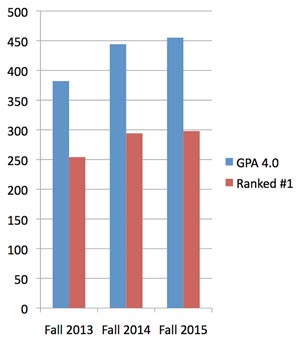Case Study: Recruiting through Analytics at the University of Oklahoma
By: Lisa Moore, Data Scientist at the Institutional Research and Reporting, University of Oklahoma

Recruiting students to a university can be a challenge when the data isn’t handled properly. Meeting the challenge can also be a challenge.
The Institutional Research and Reporting (IRR) office of the University of Oklahoma, Norman, Okla., is charged with official reporting for the university and aiding in helping the university make a variety of decisions about operations and giving guidance and providing research. As part of the administration side of the university, they react to issues that affect the total school.
One of the problems that came to the IRR was directly from the Office of the President, David L. Boren. As Lisa Moore, data scientist at IRR, explains, “The director of recruitment came to me because the president told him he needed to increase both the quality and the number of freshmen we had incoming. The director was concerned because there wasn’t a budget to increase the number of recruiters or to hand out many new scholarships to get more students to enroll. We needed to figure out another way to do this.”
Moore went to a conference where she talked to other institutional researchers. She recalls, “They said, ‘SAS has this nifty new tool called Enterprise Miner. You need to go to their booth and check it out.’ I stopped by and hung out with the SAS people so much that they should have issued a restraining order against me.”
“Being a pest can pay off. Moore says, “I got to play around with the program and saw how quickly it analyzed and mined data that I had been trying to do by hand. It was taking me weeks just to do basic regressions.”
Moore’s boss happened to be at the same conference and they sat down with the SAS staff. The result was a single desktop license to start working on the recruiting project. “And then we had the fun of trying to figure out how to collect the data and exactly how we would do this project,” Moore admits.
Moore had looked at other products before getting the SAS license but felt they were not as robust. She notes, “With one product you’re limited to a handful of different types of regressions. You can’t do the neural networks through decision trees, and it’s not quite as statistically user friendly as I wanted. With SAS, you’re still able to manipulate and set things, especially targets, the way you would want to, whereas other systems don’t allow that sort of manipulation.”
In their evaluation process, Moore ran tests of the two programs using the data she had obtained earlier.
“I ran them against what I had done by hand, and Enterprise Miner won hands down, every time. We also liked Visual Analytics to simplify our reporting, because we were doing what my boss likes to call ‘artisanal Excel reports.’ They were carefully handcrafted and we were hand entering a lot of data. Using the visual reporting, we could create interactive graphs that made it a lot easier for people to see the information. In the end, we purchased Visual Analytics, too, and have started implementing it.”


The trend in academic preparedness for applicants to the University of Oklahoma—number of students with a high school GPA of 4.0 and the number of students ranked first in the graduating high school class. There was a large jump from Fall 2013 to Fall 2014. The university had to do many things to attain that goal, some of which were unsustainable.
Implementation of a single-user desktop application should go easily and Moore acknowledges that it did, “Everything installed very easily, and then we set up the Oracle database connections. One of our programmers helped me do that, and that was all we had to do.”
The project was started in 2015. “There was a large jump in enrollment from Fall 2013 to Fall 2014, but we had to do a lot of things to attain that goal, many of which were unsustainable. The enrollment goal for 2015 was 4,200 incoming freshmen, and we nailed it right on the head,” Moore says. “We weren’t able to use predictive analysis for fall 2016 and we didn’t quite meet our goal, but in 2017 we are well on our way to surpassing the enrollment goal.”
What type of data are being using? “There are a lot of different pieces that we’re combining,” Moore explains. “There are pieces from the applications—that are supplied by the students—and we also get some information from the recruiters. When they contact students, they enter feedback that they’ve received from the students into their recruiting application. We also use data that we purchase from ACT and we add data that comes from attendance at recruiting events, especially campus tours.”
While Moore is the one doing the predictive analytics there’s a programmer who has helped in the collection of the data. And there is coordination with recruitment and admissions staffs to make certain all the data is there and available. As is often the case, both in business and academia, success leads to increased notice and increased interest by others.
“We’re definitely expanding,” Moore admits. “I’ve coordinated with other groups and formed a very close relationship with them. Recently we used information to help set goals for each recruitment region, so they know how many applications and admissions, by area, that are needed for 2018 to hit our overall enrollment target. We’ve also been working to see what they can do to increase the number of applications. We look at prospective student information and see what makes the student ultimately apply to the university. We’ve been implementing a lot of changes based on the findings.”
Being in a learning environment doesn’t mean you immediately know everything. Moore has found the SAS world is filled with helpers. “If I have a lot of questions, I can search the SAS online communities to see if somebody else has already dealt with and answered my problem. If not, I can post there and, within 24 hours, I’ll have eight different ways of solving it.”
